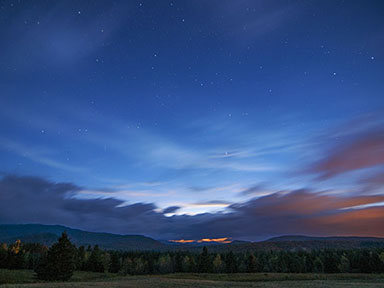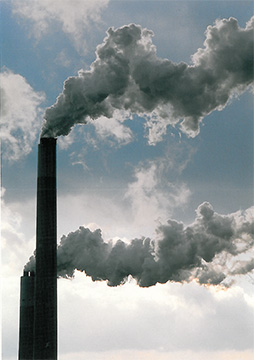
Progress on Acid Rain is Helping Adirondack Fish Survive Climate Change
By; John F. Sheehan - Adirondack Council Director of Communications
January 5, 2017
 It troubles me deeply to hear members of the Trump transition team talk about gutting the U.S. Environmental Protection Agency (EPA) and bringing back coal as a fuel for making electricity. Burning coal leads to acid rain, smog, mercury contamination, and climate change.
It troubles me deeply to hear members of the Trump transition team talk about gutting the U.S. Environmental Protection Agency (EPA) and bringing back coal as a fuel for making electricity. Burning coal leads to acid rain, smog, mercury contamination, and climate change.
New York can’t protect itself. We have some of the best clean air laws in the nation, but they aren’t enough to protect the Adirondack Park from smokestacks in the Ohio Valley, if they start burning coal again. Coal smoke from the Ohio Valley has already damaged the Adirondack Park worse than anywhere else in America.
From the 1960s through the 1990s, Adirondack scientists used state and federal funding to measure the horrendous losses we suffered. They helped us tell a story that focused national attention on solving the problem. The solution was to shut down coal-fired power plants. As a result, the pollution that causes acid rain and smog in the Adirondacks has decreased significantly.
More recently, Adirondack research scientists have had the pleasure of studying the Park’s recovery from acid rain damage. One team has identified a hopeful trend in Adirondack lakes that had been heavily damaged by acid rain, but are now recovering their vitality as pollution levels fall.
It seems that protecting a lake from acid rain also helps it resist global warming. That’s good news for our cold-water fish, such as trout and salmon – but only if acid rain doesn’t make a comeback.
In an article published in the journal Global Change Biology, the research team explains how progress against acid rain is helping to protect fish from climate change. It all has to do with how much sunlight reaches the lake bottom.
Led by Dr. Charles Driscoll of Syracuse University, the research team found that recovery from acid rain has made some very clear lakes a little murkier. While that sounds like a problem, it is not. It provides a previously unrecognized layer of protection against summertime overheating of important fisheries.
A lake that is severely damaged by acid rain looks clear as gin. Almost everything in it is dead. The research team found that lakes with very clear water heat up faster in summer than healthy lakes, which have more organic matter suspended in the water.
“As a by-product of the recovery from
acid rain, Adirondack lakes are becoming
more colored and somewhat higher in nutrients.
These conditions will help protect brook trout
in shallow lakes from the effects of summer
increases in temperature.”
Dr. Charles Driscoll
Healthy lakes have lots of green organisms and lots of dissolved organic carbon in them. The suspended carbon blocks sunlight from reaching the bottom of deeper waters. That helps keep intact a layer of cooler water that fish need to survive. Brook trout, for example, decline rapidly in waters that warm to 68 degrees Fahrenheit and above.
This added layer of protection will be critical in the years ahead, as warming summer temperatures threaten the survival of cold-water species. We will be able to keep them healthy longer in the face of rising global temperatures, if we keep acid rain from harming them again.
|
The report’s abstract noted:
However, if acid rain levels go back up again, that emerging layer of protection will disappear again and super-clear waters will warm all the way to the bottom again. The air pollutants that cause acid rain – sulfur dioxide and nitrogen oxides – have declined sharply since 1990. These declines were the result of the federal Acid Rain Program and the Cross-State Pollution Rule. Both are administered by the EPA. Both discourage one state from polluting the air in another state. The new, federal Clean Power Plan is aimed at cutting greenhouse gas emissions, but would have the side-benefit of further reducing the emissions that cause acid rain and accelerating the recovery of more Adirondack lakes. Both Congressional leaders and the new administration have been critical of the plan. More than 80 percent of the acid rain that falls on the Adirondack Park is generated In 1985, more than 700 Adirondack lakes and ponds were found to be too acidic to support their native life. The Park’s high-elevation spruce and fir forests suffered die-backs as severe as 80 percent on the slopes of some of the Park’s tallest mountains. Acid rain also worsens mercury contamination of the Park’s food web. Acid breaks down chemical compounds, turning harmless inorganic mercury (common in most forest soils) into the toxic organic form. Acid rain harms the growth of hardwood forests, including sugar maples that are prized for furniture, sporting goods, syrup and brilliant autumn foliage. In addition, acid rain has harmed the Adirondack economy by degrading the health and productivity of commercial forests and native fisheries, while discouraging tourism and outdoor recreation. The report was completed by acid rain scientists working in the southwestern Adirondack Park, including Dana Warren, Clifford Kraft, Daniel Josephson and Charles Driscoll, who presented a summary of their finding to colleagues in the Adirondacks earlier in 2016.
|







